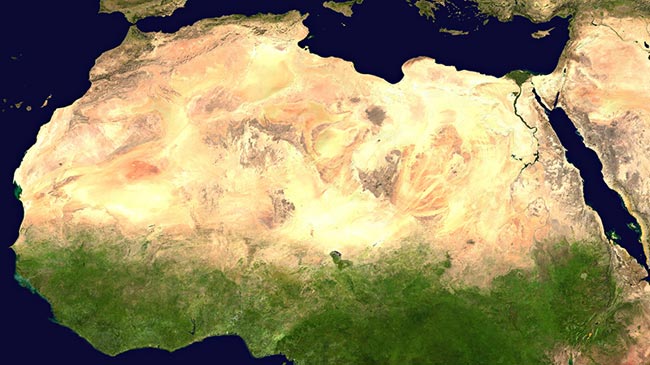Earth’s atmosphere is a thin band of air made up of numerous layers based on temperature. Without this protective blanket, life on Earth would not exist as it protects us from heat and radiation emitted from the sun and contains the air we breathe.
Though oxygen is crucial for life on Earth, it is not the primary component of our atmosphere. According to education site Vision Learning (opens in new tab) Earth’s atmosphere is composed of approximately 78 percent nitrogen, 21 percent oxygen, 0.93 percent Argon, 0.04 percent carbon dioxide as well as trace amounts of neon, helium, methane, krypton, ozone and hydrogen, as well as water vapor.
But just how high does Earth’s atmosphere extend? Well that depends on who you ask! According to NASA (opens in new tab) the upper layer of Earth’s atmosphere — the exosphere — extends up to 6,200 miles (10,000 km), above which the atmosphere and space blend. Though not everyone agrees where space actually begins, most scientists agree that the Kármán line, situated 62 miles (100 km) above sea level, marks the transition point between Earth and space. Since 99.99997 percent of Earth’s atmosphere is located below this point, it’s considered a reasonable height to draw the boundary between Earth and space.
Related: Earth’s layers: Exploring our planet inside and out
Earth atmosphere layers
Earth’s atmosphere consists of five main layers from lowest to highest: troposphere, stratosphere, mesosphere, thermosphere and exosphere.
(opens in new tab)
The layers are separated based on temperature according to the National Institute of Water and Atmospheric Research (opens in new tab) (NIWA).The atmosphere thins out in each higher layer until the gases dissipate in space. Air pressure decreases with altitude. At sea level, air pressure is about 14.7 pounds per square inch (1 kilogram per square centimeter), and the atmosphere is relatively dense. At 10,000 feet (3 km), the air pressure is 10 pounds per square inch (0.7 kg per square cm), which means molecules of gas that make up the atmosphere are less dense. That makes it harder for a person to breathe and get enough oxygen to live, although there is evidence for microbial life high up in the clouds.
Troposphere
The troposphere is the lowest and densest layer of the atmosphere and according to NIWA, approximately 75% of all the air in the atmosphere is found in this layer. The troposphere extends from Earth’s surface to approximately 5 to 9 miles (8 to 14.5 km) high.
Did you know?
According to NASA, the height of the troposphere is lower at Earth’s poles (opens in new tab) and higher at the equator.
According to NASA, “Tropos” means change (opens in new tab), and this atmospheric layer lives up to its name. Gases are constantly mixing in the troposphere and most of Earth’s weather is found here. According to educational website CK-12 (opens in new tab), turbulence in the troposphere is created when the sun warms the Earth’s surface, warming the air above. The warm air rises and then expands (due to the lower air pressure) and cools. The cool air sinks forming high pressure systems. According to WorldAtlas (opens in new tab) most helicopters and light airplanes fly in the troposphere.
Stratosphere
The stratosphere is the second layer of Earth’s atmosphere. The stratosphere begins above the troposphere and extends approximately 31 miles (50 km) high. According to NIWA, most of the ozone found in Earth’s atmosphere is in the stratosphere. Ozone protects us by absorbing harmful UV rays from the sun. The absorption of UV radiation heats up the stratosphere and temperatures in this layer actually increase with height. According to Weather.gov (opens in new tab) temperatures in the stratosphere range from approximately -60 degrees Fahrenheit (-51 degrees Celsius) at the bottom to 5 degrees F (-15 degrees C) at the top. Commercial airplanes tend to fly in the lower stratosphere so as to avoid the weather systems in the troposphere, according to aviation education site Aero Corner (opens in new tab).
Mesosphere
The mesosphere is the third layer of Earth’s atmosphere. According to NASA the mesosphere begins just above the stratosphere and extends to approximately 53 miles (85 km) high.
The top of the mesosphere, called the mesopause, is the coldest part of Earth’s atmosphere, with temperatures averaging about minus 130 degrees F (minus 90 degrees C) according to the National Center for Atmospheric Research (opens in new tab). The mesosphere is tricky to analyze as jets and balloons don’t go high enough but satellites fly too high to directly study the layer. We do however know that most meteors burn up in this layer, and high-clouds known as noctilucent clouds (also known as polar mesospheric clouds) occasionally form in the mesosphere.
Thermosphere
The fourth layer of Earth’s atmosphere is the thermosphere. It begins just above the mesosphere and extends to approximately 372 miles (600 km) high, according to NASA. The thermosphere is another atmospheric layer where temperatures rise with altitude, according to NIWA. The warming is caused by the absorption of ultraviolet light and X-rays emitted from the sun.
The thermosphere is considered part of Earth’s atmosphere, but air density is so low that most of this layer is what is normally thought of as outer space. In fact, this is where the space shuttles flew and where the International Space Station orbits Earth.
Exosphere
The exosphere is the highest layer of Earth’s atmosphere and extends from the top of the thermosphere approximately 6,200 miles (10,000 km) above Earth’s surface according to NASA. The exosphere is composed of particles of hydrogen and helium, that are so widely dispersed they rarely collide.
Ionosphere
The ionosphere is a very active layer (opens in new tab) of Earth’s atmosphere that spans the mesosphere, thermosphere and exosphere, according to NASA. It is not a distinct layer and actually grows and shrinks depending on how much energy it is absorbing from the sun.
We have the ionosphere to thank for the beautiful aurora displays that dance across the night sky. Here, the ions from solar wind collide with atmospheric oxygen and hydrogen molecules, exciting them into higher states of energy. The atoms shed this excess energy by emitting photons of light, which we see as the colorful aurora borealis and aurora australis.
What’s the difference between weather and climate?

(opens in new tab)
Broadly speaking weather refers to short-term changes in atmospheric conditions whereas climate refers to the average weather conditions of a specific location over an extended period of time according to the United States Geological Survey (opens in new tab). The National Oceanic and Atmospheric Administration (opens in new tab) (NOAA) further describes the difference simply as “climate is what you expect, weather is what you get”.
Regional climate is defined by the University Corporation for Atmospheric Research (opens in new tab)as the average weather in a place over more than 30 years. A region’s climate is often described, for example, as sunny, windy, dry, or humid. These can also describe the weather in a certain place, but while the weather can change in just a few hours, climate changes over a longer span of time.
Earth’s global climate is an average of regional climates. The global climate has cooled and warmed throughout history. Today, we are seeing unusually rapid warming. The scientific consensus, as stated by the Intergovernmental Panel on Climate Change (opens in new tab) (IPCC), is that greenhouse gases, which are increasing because of human activities, are trapping heat in the atmosphere.
Related: 7 solar system worlds where the weather is crazy
Earth, Venus and Mars: Compare the air

(opens in new tab)
To better understand the formation and composition of Earth, scientists sometimes compare our planet with Venus and Mars. All three of these planets are rocky in nature and are part of the inner solar system, meaning that they are in between the sun and the asteroid belt.
Venus’ atmosphere is almost entirely composed of carbon dioxide. The entire planet is shrouded in thick toxic sulfuric acid clouds that trap heat, resulting in what is known as a runaway greenhouse effect. As such, Venus is the hottest planet in the solar system despite being the second closest planet to the sun.e. Spacecraft have to be heavily reinforced to survive the crushing pressure (90 times heavier than Earth), and the oven-like surface temperatures (900 Fahrenheit or 475 Celsius) hot enough to melt lead (opens in new tab), according to NASA . s that Venus has no significant seasonal temperature changes.
Mars’ atmosphere is also mostly composed of carbon dioxide, with traces of nitrogen, argon, oxygen, carbon monoxide and some other gases. The Red Planet’s atmosphere is about 100 times thinner than Earth’s — a very different situation from the ancient past, when geological evidence shows that Mars used to be much wetter and warmer (opens in new tab) billions of years ago, according to NASA. S. If you were to stand on Mars and look to the sky, you’d be greeted with a red hue caused by dust particles suspended in the air, rather than the blue skies we see here on Earth. Due to Mars’ thin atmosphere, heat from the sun quickly escapes the planet. According to NASA, if you stood on the Martian equator at noon, your feet would experience a toasty 75 degrees Fahrenheit (24 degrees Celsius) though temperatures at your head would be rather chilly at around 32 degrees Fahrenheit (0 degrees Celsius).
Scientists routinely compare small, rocky exoplanets to Earth, Venus and Mars to get a better sense of their habitability. The routinely accepted definition of “habitability” is that a planet is close enough to the star for liquid water to exist on its surface. Too far, and the water turns icy; too close, and the water evaporates. However, habitability not only depends on the star-planet distance, but also the planet’s atmosphere, the star’s variability, and other factors.
Additional resources
You can explore the ionosphere in more detail with the National Weather Service (opens in new tab) and learn more about the historic increase in atmospheric carbon dioxide from Climate.gov (opens in new tab). If you fancy reading about the fascinating world of the atmospheric microbiome (opens in new tab) then check out this interesting article in Scientific American.

